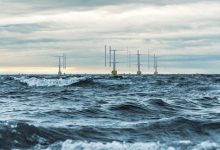The prospects for Swedish vertical axis offshore wind turbine technology were given a boost this week with the announcement of a collaboration with offshore engineering specialist Crest Consultants and the company behind the floating turbines, SeaTwirl.
SeaTwirl announced on Monday that the partnership aimed to identify offshore areas suitable for the innovative turbines, to develop concept products for the Brazilian offshore wind market, and ultimately collaborate on commercial projects.
“Brazil is an exciting market with very good conditions for offshore wind power, as there are both a lot of coast and a large offshore industry”, said SeaTwirl’s interim CEO Peter Schou.
The company said the South American nation was “ideally equipped for offshore wind power,” with its 7,000km coastline, favourable natural conditions, and an oil industry that was increasing its focus on renewable energy.
 A first stage of the collaboration would include the conducting of a feasibility study, partly financed with a SEK 50,000 grant from Offshore Väst, the statement said.
A first stage of the collaboration would include the conducting of a feasibility study, partly financed with a SEK 50,000 grant from Offshore Väst, the statement said.
SeaTwirl’s technology, first unveiled as a concept in 2011, uses a complex looking vertical-axis wind turbine with a tower connected to a sub-sea structure, made up of a floating element and a keel.
As Recharge News rather neatly explains it, “it is engineered to rotate as one unit, from blade-tip down the length of its axle, turning a direct-drive permanent-magnet generator, with seawater drawn into the structure through the shaft by centrifugal force, and then released during low-wind periods to maintain the turning momentum — like a figure-skater pirouetting — so that the turbine operates like a flywheel.”
Around the tower, above the water surface but below the wind turbine, is an enclosed, stored generator housing that stays still, and anchors the turbine to the seabed by several catenary mooring lines.
The inventor of the technology, and founder of SeaTwirl, Daniel Ehrnberg, has a Master of Science in physics and received an award from King Carl XVI Gustaf in 2010 for his work in the “sustainable development of wave energy.”
The Gothenburg-based company also has some decent wind industry chops, with a long-term collaboration deal in place with engineering giant Siemens, and former MHI Vestas Offshore CEO Jens Tommerup on its board.
The company is currently working on a 1MW rated capacity SeaTwirl S2 (pictured above), which is scheduled for completion by 2021 – a project based around a 2018 deal to supply electricity to Norwegian regional utility Haugaland Kraft.
“Our ambition is to sell our first commercial unit to a leading energy company and then establish a floating offshore wind farm in 2025,” the company says.
According to SeaTwirl, its turbine designs have numerous advantages over their much larger, horizontal axis brethren in that they can be anchored in much deeper water, where winds are stronger and more reliable.
Its turbines are spruiked as affordable to produce, inexpensive to maintain – the entire generator and bearing housing can be replaced just above the water surface by boat – and “safe and durable,” and thus can produce renewable energy at a lower cost than other technologies.
The SeaTwirl S2 follows up on the S1 model (pictured below) a 30kW prototype of which was installed off the coast of Lysekil in July 2015, “by a small and ambitious group on a limited budget” and, according the the company, is still going strong.
“SeaTwirl S1 is one of the very few floating wind power projects in the world to have been launched and operated for a longer period of time,” the website says.
“SeaTwirl S1 has withstood harsh weather conditions, autumn and winter storms reaching hurricane wind speeds. This shows how robust our design is.”








